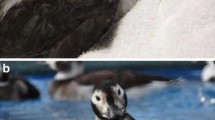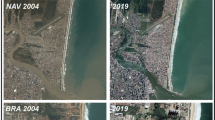Summary
Adélie penguins Pygoscelis adeliae appear to be little perturbed by man. We examined the incidence of nest desertion and duration of foraging trip in Adélie penguins when manipulated and fitted with devices of differing sizes. Birds with ca. 1 cm clipped from their tail feathers stayed at sea 50% longer than unmarked controls. The length of foraging trip and incidence of nest desertion increased with increasing device volume. Penguins fitted with devices did not reduce foraging trip length to that of unpackaged birds for at least 19 days. The susceptibility of Adélie penguins to disturbance should be carefully considered when activity patterns are being studied.
Similar content being viewed by others
References
Boyd JC, Sladen WJL (1971) Telemetry studies of the internal body temperatures of Adélie and Emperor penguins at Cape Crozier, Ross Island, Antarctica. Auk 88:366–380
Culik B, Adelung D, Woakes AJ (1989) Effects of stress on Adélie penguins (Pygoscelis adetiae) during the breeding season. Proc V SCAR Symp Antarct Biol, Hobart, Australia
Duncan IJH, Fisher JH (1980) The use of radio telemetry devices to measure temperature and heart rate in domestic fowl. In: Amlaner CJ, Macdonald DW (eds) A handbook on biotelemetry and radio tracking. Pergamon Press, Oxford, UK, pp 579–588
Heath RJM (1985) A feasibility study of Jackass Penguin Spheniscus demersus behaviour at sea using radio-telemetry. MSc thesis, University of Port Elizabeth, South Africa
Kanwisher JW, Williams TC, Teal JM, Lawson KO (1978) Radiotelemetry of heart rates from free-ranging gulls. Auk 95:288–293
Kooyman GL, Drabek CM, Elsner R, Campbell WB (1982) Diving behavior of the Emperor Penguin (Aptenodytes forsteri). Auk 88:775–795
Lishman GS (1985) The comparative breeding biology of Adélie and Chinstrap Penguins Pygoscelis adeliae and P. antarctica at Signy Island, South Orkney Islands. Ibis 127:84–99
Lishman GS, Croxall JP (1983) Diving depths of the Chinstrap Penguin (Pygoscelis antarctica). Br Antarct Surv Bull 61:21–25
Naito Y, Asaga T, Ohyama Y (1989) Diving behaviour of Adélie penguin determined by a new type of Time Depth Recorder (TDR). Proc Vth SCAR Symp Antarct Biol, Hobart, Australia
Oelke H (1975) Breeding behaviour and success in a colony of Adélie Penguins at Cape Crozier, Antarctica. In: Stonehouse B (Ed) The biology of penguins. Macmillan Press, London Basingstoke, UK, pp 363–396
Sadleir RMFS, Lay KR (1989) Foraging movements of penguins, with emphasis on a study of Adélie Penguins Pygoscelis adeliae in McMurdo Sound. In: Darby J, Davis L (eds) Penguins. Academic Press, Florida
Spurr EB (1975) Communication in the Adélie Penguin. In: Stonehouse B (ed) The biology of penguins. Macmillan Press, London Basingstoke, UK, pp 449–502
Thompson RB (1977) Effects of human disturbance on an Adélie Penguin rookery and measures of control. In: Llano GA (ed) Adaptations within antarctic ecosystems. Smithsonian Institute, Washington DC, pp 1177–1180
Whitehead MD (1989) Maximum diving depths of the Adélie Penguin, Pygoscelis adeliae, during the chick rearing period, in Prydz Bay, Antarctica. Polar Biol 9:329–332
Williams AJ, Cooper J, Newton IP, Phillips CM, Watkins BP (1985) Penguins of the world: a bibliography. University Press, Cambridge, UK
Wilson GJ (1983) Distribution and abundance of Antarctic and subAntarctic penguins: a synthesis of current knowledge. Biomass Sci Ser 4:1–46
Wilson RP (1984) An improved stomach pump for penguins and other seabirds. J Field Orn 55:109–112
Wilson RP, Bain CAR (1984) An inexpensive depth gauge for penguins. J Wildl Manage 48:1077–1084
Wilson RP, Wilson MP (1989a) Tape: a package attachment technique for penguins. Wildl Soc Bull 17:77–79
Wilson RP, Wilson MP (1989b) A peck activity record for birds fitted with devices. J Field Orn 60:104–108
Wilson RP, Grant WS, Duffy DC (1986) Recording devices on freeranging marine animals: does measurement affect performance? Ecology 67:1091–1093
Wilson RP (1989) Diving depths of Gentoo Pygoscelis papua and Adélie Penguins P. adeliae at Esperanza Bay, Antarctic Peninsula. Cormorant 17 (in press)
Wilson GJ, Taylor RH, Barton KJ (1989) Long term impact of Adélie Penguins at Cape Hallett. Proc V SCAR Symp Antarct Biol, Hobart, Australia
Wilson RP, Nagy KA, Obst B (1989a) The foraging range of penguins. Polar Rec (in press)
Wilson RP, Spairani HJ, Coria NR, Culik B, Adelung D (submitted) Packages for attachment to seabirds: what colour do Adélie Penguins dislike least? J Wildl Mange
Woakes AJ, Butler PJ (1986) Respiratory, circulatory and metabolic adjustments during swimming in the diving duck Aythia fuligula. J Exp Biol 120:215–231
Author information
Authors and Affiliations
Rights and permissions
About this article
Cite this article
Wilson, R.P., Coria, N.R., Spairani, H.J. et al. Human-induced behaviour in Adélie penguins Pygoscelis adeliae . Polar Biol 10, 77–80 (1989). https://doi.org/10.1007/BF00238293
Received:
Accepted:
Issue Date:
DOI: https://doi.org/10.1007/BF00238293




